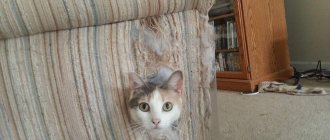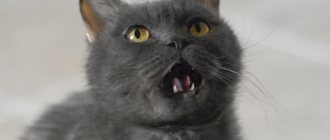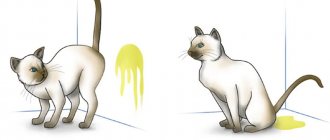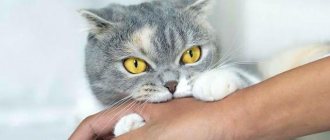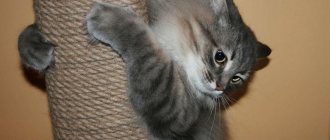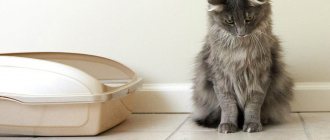What will you learn from the article?
- Why cats scratch furniture and wallpaper Physiological reasons
- Psychological reasons
- Behavioral reasons
- Step 1. Buy a scratching post
Sharpening claws is a natural need of a cat that must be satisfied. Domestic cats are deprived of their natural ability; they sharpen their claws on surfaces that remind them of the structure of wood. Often the choice of pets falls on wallpaper, corners of rooms and furniture.
In this article:
- Let's talk about the reasons why cats sharpen their claws on furniture and wallpaper;
- we will teach you how to stop a cat from tearing up wallpaper;
- We’ll show you how to save furniture from cat claws;
- We will recommend weaning methods and special repellents.
Why do cats scratch furniture and wallpaper?
The main function of scratching claws is to maintain the sharpness of the cat's hunting weapon. But this is not the only reason why a cat scratches wallpaper and tears up furniture.
To get rid of a bad habit, you must first understand the reasons for the unwanted behavior.
Physiological reasons
- Keeping claws sharp. A predator's claws must be sharp so as not to miss its prey.
- Exfoliation of the top dead layer of the claw.
- Claw marks and the smell of secretions released by the paw pads help the animal mark its territory.
- Warm up. When a cat sharpens its claws, it stretches to its full height, stretches its spine and muscles.
- Ritual of communication with other cats. Many animals stretch and scratch their claws in the presence of their fellow tribesmen.
Psychological reasons
The animal's psycho-emotional state pushes it to tear apart the sofa and wallpaper.
A cat scratches if:
- he is jealous. This way he can express his dissatisfaction with the fact that small children or new pets have appeared in the house.
- experiencing stress. A restless environment around the animal serves as a basis for scratching. Cats painfully endure preparations for moving, renovation work in the house, and the appearance of a cat in the next apartment.
- defends its interests and fights for territory. A tense relationship with a new pet or hostility between two cats will inevitably lead to claw marks on furniture and walls. This is how cats mark their territory and spread their scent over it.
- plays. A piece of wallpaper accidentally torn off while scratching a wall can encourage the animal to continue this activity. The hosts' reaction to this incident, even negative, makes the game even more exciting.
- doesn't feel safe. The pet tries to increase its security by spreading its scent throughout the apartment using scratches.
Behavioral reasons
- Lack or lack of education. A kitten scratches furniture and tears wallpaper if it was not taught to use a scratching post from an early age and its attempts to sharpen its claws wherever it wants were not stopped.
- Adult animals may behave inappropriately due to a change in owner, relocation, lack of attention from the owner, or deterioration in living conditions.
How to avoid mistakes
Many people, when they get a small kitten, perceive it as a living toy, imagining that keeping it will not cause any problems. But when the baby begins to misbehave: he spoils the wallpaper with his claws or “combs” the upholstered furniture, they begin to punish the fluffy, who, oddly enough, becomes more and more naughty day by day and causes more and more damage to the environment.
If your cat has already chosen a piece of furniture or a piece of wall for a claw point, you need to protect this place.
If someone has this exact perception of a cat, it is better not to get one at all. The handsome tailed cat needs to be educated from the first days of his life, and if the time for education is lost, then he needs to be re-educated. To do this, be patient, don’t get angry and don’t punish the baby.
A cat pulls wallpaper much more often if its claws are long enough and it catches on everything.
In order not to raise a small cat into a big egoist and not turn into his slave, it is worth familiarizing yourself with the methods of proper handling of cats. The owner must help the baby learn order, calmly and purposefully.
In nature, cats sharpen their claws on a tree trunk, thus marking their territory.
In addition, it is worth familiarizing yourself with the experience of other owners who highlight the most significant mistakes in raising four-legged animals and not repeating them:
- You cannot punish an animal;
- You should stop trimming your nails yourself and contact a veterinarian for help;
- It is better to keep the old scratching post - the animal may not like the new one, but it is better to place it at the front door or near the bed;
- If the scratching post still needs to be replaced, then objects should be placed next to it that will distract the fluffy’s attention from his destructive actions.
Cats often damage furniture in the house.
How to stop a cat from tearing furniture and wallpaper
Don't hold a grudge against cats, don't scold them for ruining wallpaper, carpet and furniture. Animals do this unintentionally, not with the intention of harming the owner. They act at the level of instincts inherent in nature.
To protect furniture, new wallpaper, carpeting, it is necessary to identify the cause of the behavior and eliminate it. If your animal is suffering from stress, seek help from a veterinarian or animal psychologist. If the reasons for scratching are not related to the psycho-emotional state of the pet, be patient to instill good manners in the cat.
Step 1. Buy a scratching post
Buying a scratching post that your cat will like is the best solution to the problem of sharpening its claws in the wrong places. Offer your cat several models, place them in different places. The animal must have a choice. For each pet in the house there should be at least two scratching posts of different textures and directions.
This cat accessory will allow your pet to satisfy its physiological needs. If the animal appreciates the capabilities of the scratcher, then you don’t have to worry about the wallpaper and furniture. Be patient and consistent; it may take several months to train your claws to scratch in the right place.
Read more: how to train a cat to use a scratching post.
Step 2: Create a safe personal space
Scratches on wallpaper and furniture can be a special form of marking and indicate a cat's insecurity. Reasons for concern for a pet may be neighbor's animals entering the area, quarrels between owners, or a conflict between the cat and other pets.
Repairing and replacing furniture is stressful for a cat. During repairs, animal odors that help you feel safe in the house are destroyed. They are replaced by foreign aromas of building materials, new furniture and floor coverings. This worries the pet. The cat scratches things and wallpaper to make the space of the house more friendly, transmitting its smell to it.
How an owner can help an animal feel more confident
- Install cat doors to keep other animals out of your home.
- Monitor relationships between pets. Create for everyone their own resting place, preferably on an elevation, to make it more convenient to observe what is happening in the house. Provide each pet with its own litter tray.
- Give the cat its own place in the house. Create an area for playing and climbing, provide a house in which the animal can hide and be alone.
- Help your cat spread its scent around the house after renovating and replacing furniture. To do this, rub the animal's cheeks with a soft cloth, and then wipe the corners of the house, furniture legs, and door frames with this cloth.
- Never physically punish unwanted behavior. The owner should be a source of security for the cat, and not an additional threat.
Step 3. Trim nails regularly and use anti-scratch guards
Regular cat manicures will protect walls and furniture from sharp claws. If you carefully cut off the dead part of the claw as it grows, then the cat will not have the desire to sharpen its claws again. You can trim your nails at home, using caution. Or entrust this procedure to a professional from a grooming salon.
The Anti-Scratch claw device is another useful accessory that protects the home’s furniture and wallpaper from damage. These soft pads avoid the controversial and very painful declawing procedure. Cats wearing anti-scratch guards will also sharpen their claws, but will not harm any surfaces.
Step 4: Clean scratched areas
When cats use scratches as territorial marks, they return to refresh the mark. To prevent your pet from returning to the scratch site again and again, clean it thoroughly. Try to completely remove the cat odor using detergents and disinfectants.
To stop a cat from scratching the sofa, the soft upholstery is washed with a solution of washing powder and then wiped with an alcohol-containing liquid. While the treatment area dries, the cat should be kept in a separate room. After drying, this place can be additionally treated with a spray with a citrus scent or use a special “Anti-claw” spray.
Step 5. Use aids
You can use strong smells that repel cats to wean your pet from a bad habit. Cats have an excellent sense of smell; strong-smelling substances are unpleasant and repulsive to them. If you spray one of these scents on a surface that your pet uses for sharpening its claws, your cat may give up the habit.
Most often used to wean off scratching:
- citrus aromas;
- acetic acid;
- essential oils (eucalyptus, lavender, lemongrass);
- strong alcohol;
- sharp perfume.
Spraying is carried out using a spray bottle. The repellent is pre-diluted in water. Choose those scents that will not be unpleasant to the owners and will not greatly spoil the smell in the apartment.
Instead of these home remedies, you can use special products to stop cats from scratching. These sprays are sold in pet stores and veterinary pharmacies. Next, we will talk about the best means and their cost.
Another way to protect your furniture is to apply double-sided tape to the scratched areas. Cats do not like sticky surfaces; touching the tape with their paws will be unpleasant for them. The animal will no longer scratch in this place.
Step 6. Choose the right wallpaper
While furniture can be sprayed with professional or homemade repellents to protect against cat claws, wallpaper is more difficult to save. After spraying the “crime scene,” stains and unpleasant stains remain on the wallpaper. In addition, odors from wall surfaces evaporate faster; the procedure will have to be repeated again and again.
What wallpaper to choose if there is a cat in the house:
- non-woven;
- wallpaper with silk-screen printing;
- washable wallpaper.
A real salvation from cat pranks is anti-vandal wallpaper. This is a new wear-resistant type of finishing materials. To enhance the wear resistance of this wallpaper, the manufacturer uses additional external coating and reinforcement.
Types of anti-vandal wallpaper:
- vinyl “anti-claw”;
- fiberglass for painting;
- non-vandal resistant non-woven fabrics for painting;
- laminated;
- textile-based vinyl;
- vinyl on non-woven base.
No covering, even the most stable one, will be able to wean a cat from a bad habit unless you buy him a scratching post and teach him to use it.
How does a cat's claw work?
A cat's paw is designed in such a way that each claw has its own case, into which it is retracted when the cat walks or runs. The work of ligaments and tendons ensures that they are pulled into the pads and instantly released if necessary.
© shutterstock
The claw also has a complex structure. It consists of two parts: internal and external. Internal is soft bone tissue penetrated by vessels and nerves. The outer shell is a special type of protein (keratin) that protects the inside of the claw from damage.
Cat claws grow throughout their lives. The keratinized layer must be removed, otherwise the claws will become too long and will not fit into their cases. They will become dull when they come into contact with the soil. With such claws, a cat will not be able to climb a tree, hold onto prey, or protect itself from attack. Thanks to constant cleaning, a cat's paw with sharp claws is a formidable weapon capable of causing deep wounds. A cat always sharpens the claws on its front paws. They are the striking force of the predator.
Useful tips for cat owners
- Don't rush to throw away your old scratching post. If you purchased a new accessory for sharpening cat claws, place it next to the old claw grinder, which is saturated with familiar odors. Throw away the old one only when the animal gets used to the new one.
- Use the Kuklachev method. To stop a cat from scratching wallpaper, glue a piece of “favorite wallpaper” onto a board and place it in the place where the cat is used to scratching the wall. Every day the board is moved to the place where the scratching post is located.
- Applaud the cat. As soon as the animal begins to sharpen its claws in the wrong place, clap your hands loudly. You can hit the floor with a slipper - it will have the same effect.
- Believe in the power of your word. Sternly say “No!” when the cat starts scratching the furniture or wallpaper. Don't shout, speak confidently. Repeat this command every time your pet is about to sharpen its claws in the wrong place. Over time, he will understand that the owner does not approve of this behavior.
Rules for caring for a cat
In order for communication with a small cat to bring mutual satisfaction, it is worth knowing the rules of caring for a four-legged cat, which will not require much effort, but love and patience.
Love your pet!
- The first and main condition is personal space, a place for the animal: this can be a house or bedding on which it will sit and sleep. At the same time, you must not forget to shake out dust and wool from it, and also wash it periodically.
- Feed should be varied, nutrition should be balanced.
- If a cat lives in an apartment, from the first days of his life he needs to be trained to use a litter box.
- The coat requires care, especially if the cat is a long-haired breed.
In parallel with accustoming the cat to the scratching post, wean the cat from the places it habitually scratches.
These simple tips will help you raise a gentle, obedient and neat animal that will thank its owner for its care with a gentle purr.
Means for repelling cats from wallpaper and furniture
In veterinary pharmacies and pet supply stores you can purchase special repellents that can be used to treat furniture, walls, door frames and other places where cats sharpen their claws. The unpleasant smell of these products disgusts cats, and they avoid the treated areas.
Best scratch repellents:
- Beaphar Stop It Cat is an effective spray for repelling cats from wallpaper, furniture and indoor flowers. Price: bottle 100 ml. – 740 – 890 rub.
- Nature's Miracle, JFC Pet Block Cat Repellent Spray is a concentrated spray based on natural repellents. Price: bottle 236 ml. – 440 – 470 rub.
- Spray Mr. Fresh is a means to prevent cats from tearing wallpaper. Suitable for kittens and cats. Price: 200 ml bottle. – 180 – 280 rub.
- Spray lotion VioVax “Repel? Yes!" – based on natural ingredients, protects furniture and walls from scratching. Price: bottle 180 ml. – 123 – 160 rub.
- Api-San Smart spray - protects against chewing and scratching. Price: bottle 200 ml. – 180 – 265 rub.
Using a stern voice or loud noises
If a person is thinking about how to stop a cat from scratching wallpaper, then initially one should try to solve the problem in the simplest and most peaceful way. To do this, during such a situation, you can simply yell at your pet or scare him with loud sounds.
If you regularly repeat this exercise, the animal will develop an unpleasant association. The cat will understand that as soon as he starts tearing the wallpaper, unpleasant and loud sounds appear, causing him stress. Over time, you can wean the animal from tearing not only wallpaper, but also various interior items.
To get a loud sound, you can pop a balloon or clap your hands.
How not to wean
It is better not to use these weaning methods if you want to achieve a positive result and remain on good terms with the cat:
- Spray bottle with water. To scare away a cat, taking advantage of its dislike for water procedures, water is sprayed on its face from a spray bottle. This method may work, but the animal will begin to associate this unpleasant event with your personality and will try to take revenge.
- Scream. Remember that you can scold a cat, but you cannot shout at it. Never scream when you stop a cat with a voice command. Screaming will scare the animal, but will not bring the desired result.
- Physical punishment. You can't hit cats! The animal will get scared, harbor a grudge, and try to take revenge.
- Late identification of the problem. You can scold a cat only when you take it by surprise at the site of vandalism. If the wallpaper is already torn off, the furniture is scratched, there is no point in expressing your attitude towards this. The animal will not understand why you are scolding it.
What to do if nothing helps
To solve the problem, if it cannot be solved in other ways, you can use another option that involves unexpected loud sounds to scare away.
Go to radical methods if conventional ones do not help.
Such a factor could be:
- a loud dissatisfied shout: “You can’t!”, “Scram!”;
- the sound of a store-bought rattle;
- use a homemade “scarer” made from a tin can with a handful of coins placed in it.
Use claw covers.
Some people advise using inflated balloons to block the road to a forbidden place. However, not everyone approves of this method, so the choice is up to the owner.
Complete declawing
The cat is tearing the wallpaper, what to do in such a situation? The most drastic solution is the complete removal of the pet's claws. Many people believe that this is too cruel to the animal, so only heartless people use this method.
This procedure is called onychectomy. It lies in the fact that not only the claws themselves are subject to amputation, but also the phalanges. The process is performed exclusively under anesthesia, which is poorly tolerated by cats. A cat without claws is considered disabled, not only physically, but also mentally.
Owners of such animals note that the cat's coordination of movements is impaired, it often falls and loses its balance, and also experiences pain in the spine. Sometimes a serious consequence of such an operation is curvature of the spine. If such a cat ever ends up on the street, he will be completely defenseless, so he will not be able to fight back cats or dogs. He won't even be able to climb a tree.
How to make a scratching post with your own hands?
The most optimal way to wean a cat from walls is to attract him to a scratching post. It is sold at any pet store, and if necessary, you can make it yourself. To do this, you can take a post, which is wrapped with twine and attached to a plank, which is a solid base.
When creating such a column, the recommendations of experts are taken into account:
- the height of such a column should be greater than the length of the animal’s body;
- the base must be wide, strong and heavy so that the cat cannot knock over the structure;
- It is advisable to attach such a scratching post to the floor;
- To attract your pet, you need to attach some small toy on top.
To accustom your cat to the scratching post, you can lubricate it with catnip, but you should not overdo it with this product. Additionally, you can organize a full-fledged corner for your pet, consisting of several similar devices, a house, bedding and other entertainment. If such a complex is present, the animal will not pay attention to furniture, wallpaper or door frames in the apartment. The kitten needs to independently demonstrate how exactly to use the scratching post by running its claws along the post.
Smell repellent method
Most cats develop persistent habits, that is, they prefer to tear wallpaper in certain places.
To avoid this, you can sew fabric bags and soak them in essential citrus oil (felines do not like the smell of citrus), scattering them in these places.
But in this case, it is also important to get a scratching post, because the cat may simply start scratching another wall.
Protective covers for furniture
If a cat tears at a chair or other furniture, this always causes negative emotions among the owners of the living space. Furniture quickly loses its attractive appearance and therefore needs frequent replacement.
In order not to spend money on new sets of upholstered furniture every year, you can simply purchase high-quality and durable protective covers. They are made to order by many companies, for which individual measurements are initially taken. The material from which the covers are made can vary, so the most durable fabrics are usually chosen to protect against cat claws. They can easily withstand sharp claws and are easy to clean and wash.
